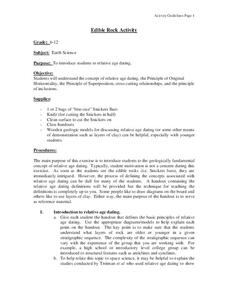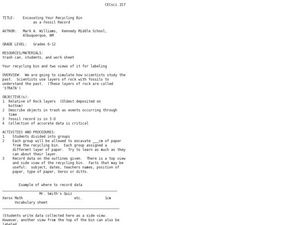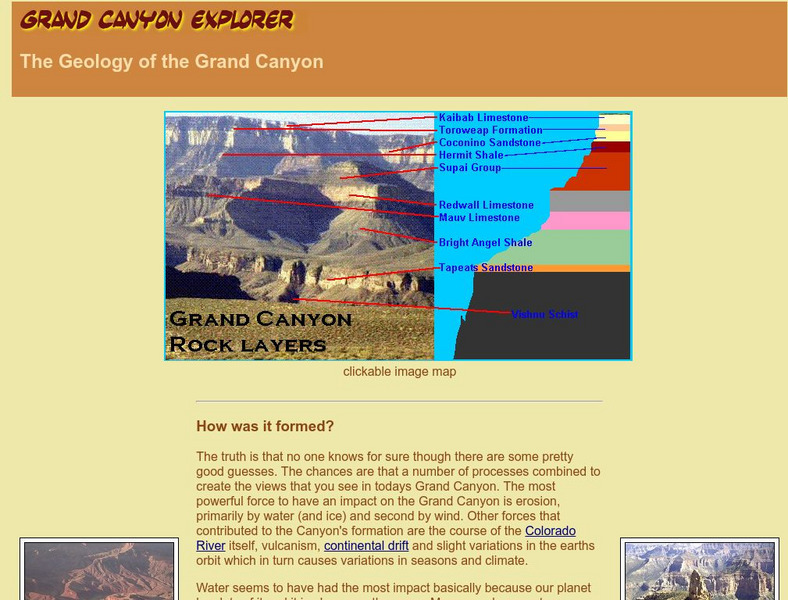Science 4 Inquiry
Layers and Laws: The Law of Superposition and Index Fossils
What can layers of rock teach us about the climate? Young scientists solve a mystery about who stole a cookie by applying the law of superposition. Then, they apply the same concept to solve a more difficult mystery, trying to determine...
Curated OER
The Rocks Under Illinois
The goal of this fine geology lesson is to have learners create a map that shows how the rock layers are arranged far underground where they can't be seen. The ambitious lesson plan requires high schoolers to learn the law of...
Curated OER
How Old Is Illinois?
High schoolers use fossils found in rocks to determine the age of the strata between Rock Island and Chicago. Pupils pretend they are geologists. They must determine the age of all rock layers between the Mississippi River and Lake...
GNS Science
Think like a Geologist: 2
All models are better in three dimensions. A hands-on lesson asks learners to create 3-D models of a rock layer using a template. They arrange the puzzle piece sides together to create models that are scientifically correct. Once the...
GNS Science
Think like a Geologist: 1
How well do pupils play the role of geologist? Test their abilities in the first installment of a two-part series. Presented with a series of rock formation diagrams, learners write stories to match what they see in the diagrams. The...
Howard Hughes Medical Institute
Using the Scientific Process to Study Human Evolution
Did humans and dinosaurs coexist? How do we know? Scholars dig in to the tools and methods researchers used to study the process of human evolution by watching a slideshow with embedded video clips. Pupils learn the importance of asking...
Curated OER
Relative Age Dating
Modeling dough and paper cutouts in science class? Learn about how relative age dating concepts, like the Law of Superposition and cross-cutting relationships, can be used to describe the formation of sedimentary layers.
Curated OER
Edible Rock Activity
Who knew Snickers® could be used to teach science? Give your budding earth scientists a chance to explore the Law of Superposition, in addition to a well-earned snack.
Curated OER
Rocks Worksheet #3
Here is a worksheet in which junior geologists determine where the igneous, metamorphic, and sedimentary rocks might be found on a diagram of rock layers in Earth.s crust. They show what they know through a series of five multiple choice...
Curated OER
Fossils and The Law of Superposition
In this fossils and the Law of Superposition worksheet, middle schoolers fill in 4 blanks with the proper terms that match definitions about fossils and rock layers. They complete 9 questions about 2 activities they performed related to...
Curated OER
Changing Crust
In this changing crust worksheet, students use candy bars, licorice sticks and bubble gum to simulate the 3 types of forces that change the Earth's crust. These include compressional forces, tensional forces and transversal forces. The...
Curated OER
Relative Ages of Rocks
In this ages of rock worksheet, students will review the processes and techniques of determine the age of rocks. Then students will use a rock layer diagram to determine what rock materials are older or younger. This worksheet has 16...
Curated OER
Creating a Rock Sequence
In this rock sequence learning exercise, students will sequence a list of 10 historical events according to the principle of superposition. Students will label these events on a cross-section diagram.
Curated OER
Geologic Age
Learners investigate rocks. In this geologic age lesson plan, students conduct an experiment to determine absolute age as one would for rock layers. Learners graph data and problem solve using results.
Curated OER
Sequence of Events
For this rock layers worksheet, students list the events needed to make the pattern of rock layers shown, ordering them from oldest to youngest. This worksheet has 15 short answer questions.
Curated OER
Rock Layers
Students interpret a rock core sample from a clay model. In small groups, they layer modeling clay in a plastic container using coarse-grained spices sprinkled in to represent fossils. They switch containers with another group and remove...
Curated OER
Core
Eighth graders examine conditions that can lead to the formations found and correlate the layers. In this rock layers lesson students complete an activity that allows students to take their own "core sample".
Curated OER
Excavating Your Recycling Bin as a Fossil Record
Students explore how scientists examine the past and use rock layers with fossils to understand the past. In this excavation activity students divide into groups and complete an activity.
Curated OER
Candy Quakes
Eighth graders use candy to show the effects of deformation forces on the earth's crust. In this rock and fossil formation instructional activity students construct models and simulations to describe and explain natural phenomena.
Curated OER
Sequence of Events Practice #5
In this rock layers worksheet, students list the events needed to make the pattern of rock layers shown from oldest to youngest. This worksheet has 15 fill in the blank questions.
Curated OER
Sequence of Events
In this rock layers worksheet, learners list the events needed to make the pattern of rock layers shown in the diagram from oldest to youngest. This worksheet has 4 short answer questions.
Curated OER
Sequence of Events
In this rock layers worksheet, students list the events needed to make the pattern of rock layers shown in order from oldest to youngest. This worksheet has 5 short answer questions.
Other
Grand Canyon Geology
Photos, illustrations, 3D graphs and animations are part of this investigation into the geology and landforms of the Grand Canyon. Learn detailed information on the formation of the canyon, the rock layers, and the prehistoric life that...
Science Education Resource Center at Carleton College
Serc: Layer Cake Geology
Using a cake analogy, this activity teaches concepts such as: geologic time, rock layers, fossils, Law of Superposition, and relative dating. Activity can be modified to grade level and appropriate content for young scholars,

























